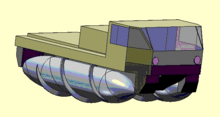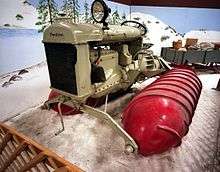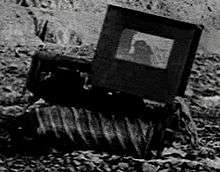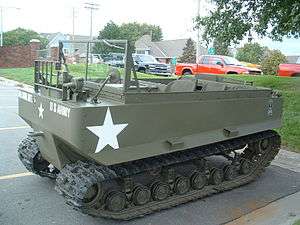Screw-propelled vehicle

A screw-propelled vehicle is a land or amphibious vehicle designed to cope with difficult snow and ice or mud and swamp. Such vehicles are distinguished by being moved by the rotation of one or more auger-like cylinders fitted with a helical flange that engages with the medium through or over which the vehicle is moving. Modern vehicles called Amphirols and other similar vehicles have specialised uses.
The weight of the vehicle is typically borne by one or more pairs of large flanged cylinders; sometimes a single flanged cylinder is used with additional stabilising skis. These cylinders each have a helical spiral flange like the thread of a screw. On each matched pair of cylinders, one will have its flange running clockwise and the other counter-clockwise. The flange engages with the surface on which the vehicle rests. Ideally this should be slightly soft material such as snow, sand or mud so that the flange can get a good bite. An engine is used to counter-rotate the cylinders—one cylinder turns clockwise and the other counter-clockwise. The counter-rotations cancel out so that the vehicle moves forwards (or backwards) along the axis of rotation.
The principle of the operation is the inverse of the screw conveyor. A screw conveyor uses a helical screw to move semi-solid materials horizontally or at a slight incline; in a screw propelled vehicle, the semi-solid substrate remains stationary and the machine itself moves.
Early developments
One of the earliest examples of a screw-propelled vehicle was designed by Jacob Morath, a native of Switzerland who settled in St. Louis, Missouri in the United States in 1868.[1] Morath's machine was designed for agricultural work such as hauling a plough. The augers were designed with cutting edges so that they would break up roots in the ground as the machine moved.[2]
One of the first screw-propelled vehicles that was actually built was designed by James and Ira Peavey of Maine. It was patented by Ira Peavey in 1907; the Peavey family has been famous for its contributions to the lumber industry ever since blacksmith Joseph Peavey of Stillwater, Maine, invented the tool known to this day as a Peavy. The Peavey Manufacturing Co. is still located in Maine.[3]
The Peaveys' machine had two pairs of cylinders with an articulation between the pairs to effect steering. At least two prototype vehicles were constructed: one was steam powered the other used a gasoline engine.[4] The prototypes worked well on hard packed snow but failed in soft powder because the flanges had nothing to grip into. The machine was designed to haul logs, but its length and rigid construction meant that it had difficulty with the uneven winter roads for which it was intended. Peavey's invention could not compete with the Lombard Steam Log Hauler built by Alvin Lombard and it was not produced commercially.[5] (The Lombard vehicle was an early example of a half-track vehicle, it resembled a railway locomotive with a sled or wheels in front for steering and caterpillar tracks for traction.)
Armstead Snow Motor

In the 1920s the Armstead Snow Motor was developed. When this was used to convert a Fordson tractor into a screw-propelled vehicle with a single pair of cylinders. A machine used in the Truckee,CA area was referred to by locals as the "Snow Devil" and that name has been erroneously attached to these machines, although no known advertising of the time referred to them as such. A film was made to show the capabilities of the vehicle as well as a Chevrolet car fitted with an Armstead Snow Motor.[6] The film clearly shows that the vehicle copes well in snow. Steering was effected by having each cylinder receive power from a separate clutch which, depending on the position of the steering gear, engages and disengages; this results in a vehicle that is relatively maneuverable. The promotional film shows the Armstead snow motor hauling 20 tons of logs.
In January 1926, Time magazine reported:
| “ | Having used the motor car for almost every other conceivable purpose, leading Detroit automobile makers have now organized a company entitled "Snow Motors Inc.," to put out a machine which will negotiate the deepest snowdrifts at six to eight miles an hour. The new car will consist of a Ford tractor power-plant mounted on two revolving cylinders instead of wheels—something on the order of a steam roller. The machine has already proved its usefulness in deep snow previously unnavigable. One such machine has done the work which formerly required three teams. In Oregon a stage line uses a snow motor in its two daily round trips over the Mackenzie Pass between Eugene and Bend. Orders are already in hand from Canada, Norway, Sweden, and Alaska. The Hudson Bay Co. has ordered a supply to maintain communications with its most northern fur-trading stations. The Royal Northwest Mounted Police have also gone into the market for snow motors, and may cease to be horsemen and become chauffeurs, to the deep regret of cinema people. A number of prominent motor makers have also been interested in the proposition from the angle of adapting the snow motors equipment to their ordinary models. Hudson, Dodge and Chevrolet are mentioned especially as interested in practical possibilities along this line.[7] | ” |
An extant example is in the collection of the Hays Antique Truck Museum in Woodland, California. This particular vehicle is said to have been used to haul mail from Truckee to North Lake Tahoe.[8]
The Second World War period


With the occupation of Norway by Nazi Germany in World War II, the quixotic Geoffrey Pyke considered the problem of transporting soldiers rapidly over snow. He proposed the development of a screw-propelled vehicle based on the Armstead snow motor.[9] Pyke envisaged that the vehicles would be used by a small force of highly mobile soldiers. The damage and casualties that a small force could inflict might be slight, but they would oblige the enemy to keep many men stationed in Norway in order to guard against every possible point of attack. Pyke's ideas were initially rejected, but in October 1941, Louis Mountbatten became Chief of Combined Operations and Pyke's ideas received a more sympathetic hearing. Mountbatten became convinced that Pyke's plan was worthwhile and adopted it. The scheme became Project Plough and many high-level conferences were dedicated to it.[10]
The problem of developing a suitable vehicle was passed to the Americans, and Pyke went to the USA to oversee the development. However, Pyke, who could be very inflexible, fell out with various individuals on the project and the Americans moved on to design a more conventional tracked vehicle, the M29 Weasel.[11]
In 1944, Johannes Raedel, a soldier of the German Army and veteran of the Eastern Front invented his schraubenantrieb schneemaschine (screw-propelled snow machine). Raedel had seen the problems of operating tracked vehicles in the deep snows of Russia where a tank would dig out the snow under the tracks leaving the tank stuck on the snow compressed under the hull.[12]
According to Siegfried Raedel, son of Johannes:
| “ | The vehicle idea evolved while looking at a meat mincer, also employing a screw type of compression. He convinced the OKH in Berlin to allow him to make a prototype of his concept machine. At that time, Austria was annexed to Germany already and he was dispatched to the Austrian Alpine Vehicle Test Center at St. Johann in Tyrol.
Using whatever materials were available, he built a working prototype during the period of 10 February 1944 to 28 April 1944. It was tested extensively. It was very slow, but it could pull one ton. It also possessed good climbing capabilities. It would penetrate about 30cm into the snow, but no more. Raedel's machine never went into production.[12] |
” |
Amphibians
The threaded cylinders are necessarily large to ensure a substantial area of contact and buoyancy. Being lightweight, the cylinders may conveniently serve as floats and the arrangement may be used in the design of an amphibious vehicle.
During the Vietnam War, the American Waterways Experiment Station (WES) tested the Marsh Screw Amphibian, designed by the Chrysler Corporation.[13][14] The counter rotating screws "...propelled the vehicle through water and marsh terrain adequately, but failed miserably on soil surfaces, especially sand. The average maximum speed attained on test lanes was a meagre 1.6 miles per hour (2.6 km/h; 1.4 kn)."[15] Despite such disappointing results, Chrysler produced a much larger vehicle, the Riverine Utility Craft (RUC) for the Navy in 1969. The RUC travelled on two aluminium rotors, 39 inches (991 mm) in diameter. The RUC achieved impressive speeds of 15.7 knots (29.1 km/h) on water and nearly 25 knots (46 km/h) on marsh. Again, however, speeds on firm soils proved disappointing, reaching only 3.6 knots (6.7 km/h) and crossing dykes proved difficult – the vehicle would get stuck.[16]
The Soviets built a screw-propelled vehicle, the ZIL-2906, specifically for the challenging task of recovering cosmonauts who landed in inaccessible areas.
In the 1960s, Joseph Jean de Bakker was the busy owner of the De Bakker machine factory in Hulst in the southwest of the Netherlands. He was also a keen fisherman, but he did not want his fishing time to be constrained by the vagaries of the tide. His solution was the Amphirol, a screw-propelled vehicle superficially similar to the Marsh Screw Amphibian. The Amphirol was able to convey him over the sticky clay revealed by the outgoing tide and to swim in water at high tide.[17][18]
De Bakker's Amphirol had a top speed of 12 km/h (6.5 knots) on mud and 10 km/h (5.4 knots) in water. It was powered by two modified DAF 44/55 variomatic transmission units; this made possible the significant innovation that the flanged cylinders could be deliberately driven in the same direction so that the vehicle could crab sideways on dry land at the alarming speed of 30 km/h (16 knots). Also, when moving sideways, steering is effected by shifting the front of the cylinders so that they are no longer parallel – giving a large minimum turning radius.
Amphirols are used for ground surveying, for grooving the surface of newly drained polders to assist drying, and to carry soil-drilling teams.[19]
Today, modern vehicles widely known as amphirols, perform specialised tasks such as compacting tailings from industrial processes. The advantage of these machines to tailings densification is by way of providing a means to allow water or process liquor to run off without repulping the profile. This approach subsequently largely negates the impact of rainfall on densification and dewatering. However, the lighter, faster machines are better suited to marginal terrain access, but not densification due to repulping and their limited penetration depth. The process of using these machines specifically for tailings and dredge spoil densification is commonly termed "mud farming" in the mining industry.[20]
Recent developments
The British Ice Challenger exploration team used a screw drive in their Snowbird 6 vehicle (a modified Bombardier tracked craft) to traverse the ice floes in the Bering Strait. The rotating cylinders allowed Snowbird 6 to move over ice and to propel itself through water, but the screw system was not considered suitable for long distances, and the cylinders could be raised so that the vehicle could also run on conventional caterpillar tracks. The Ice Challenger website says that the design was inspired by a Russian vehicle used to pick up cosmonauts who landed in Siberia (perhaps the ZIL-2906).[21]
Russian inventor Alexey Burdin has come up with a screw-propulsion system "TESH-drive Transformable worms".[22]
More recently, commensurate with the ever increasing demand for commodities whilst refinery operational footprints remain within set boundaries, mud farming with the larger machines with deep profile penetration capacity (termed MudMasters by their manufacturer) has proven to be an efficient method for high intensity tailings management.[23]
Popular culture
- A screw driven vehicle has been produced as a toy by Mattel.[24] [Tyco Twister]
- In the video game Metal Gear Solid 3: Snake Eater, a screw drive powers the fictional vehicle Shagohod.
- In the intro of the video game Command & Conquer: Red Alert 2, the (fictional) Soviet amphibious transports are using screw drives for movement. In the video game, Toy Soldiers: Cold War for Xbox 360, an opposing vehicle is the ZIL 2906.
- The first DLC for the videogame Fallout 3, Operation: Anchorage, features Chimera Tanks that uses screw drives as a means of movement.
See also
References
Notes
- ↑ Pen and Sunlight Sketches of Saint Louis: The Commercial Gateway to the South. Chicago: Phoenix Publishing. 1892. p. 268.
- ↑ US patent 635501, J. A. Morath, "Agricultural Machine", issued 1899-05-18 An early patent for an auger driven farm tractor.
- ↑ "History of The Peavey". Peavey Manufacturing Co. Retrieved 7 January 2009.
- ↑ "1907 Screw Drive Vehicle". Patent Pending Blog – Patents and the History of Technology. Retrieved 7 January 2009.
- ↑ Lore A Rogers & Caleb W Scribner. "Lombard Steam Log Hauler" (pdf). American Society of Mechanical Engineers. Retrieved 6 January 2009.
- ↑ SeekingMichigan. "Armstead Snow Motors" (FLV). Vimeo. Retrieved 25 December 2009.
The Armstead Snow Motor Company put out this product demo in 1924.
- ↑ "Snow Motors". Time. 4 January 1926. Retrieved 14 January 2009.
- ↑ "Collection – Fordson Snowmobile 1926". The Heidrick Ag History Center. Retrieved 14 January 2009.
This machine hauled mail from Truckee to North Lake Tahoe.
- ↑ Lampe, 1959, pp91–95.
- ↑ Lampe, 1959, p97.
- ↑ "OSS Briefing Film – The Weasel". Real Military Flix. Retrieved 28 January 2009.
- 1 2 Rob Arndt. "Raedel SchraubenantrieB Schneemaschine (Screw Propulsion Snow Vehicle) (1944)". Retrieved 19 January 2010.
- ↑ "For water, mud, marsh, sludge, slosh, slough, bog, fen, morass, quagmire, snow, slush, sand, silt, muck & mire (advertisement)". Life Magazine: 35..36. Retrieved 12 December 2012.
- ↑ New American Swamp Vehicle - The Marsh Screw. Pathe News. 1964. Retrieved 13 December 2012.
- ↑ Fatherree, Dr. Ben H. "Chapter 8 – The Vietnam Era and Beyond: Mobility and Environmental Studies, 1963–1978". The History of Geotechnical Engineering at the Waterways Experiment Station 1932–2000. Retrieved 28 January 2009.
- ↑ Owen, A. Y. "Marsh Screw (images)". Time & Life Pictures. Getty Images. Retrieved 28 January 2009.
- ↑ Joris Bracke quoted by Hans Rosloot (October 1969). "Amphiroll". The Source of Amphibious Vehicle Information. Retrieved 30 January 2009.
- ↑ "Go Anywhere Transport". Pathe News. 1966. Retrieved 1 March 2010.
- ↑ (editorial) (October 1969). "Mud Lark". Design. VADS – The Online Resource For The Visual Arts. Retrieved 29 January 2009.
- ↑ Cooling, D.J. "Improving the Sustainability of Residue Management Practices — Alcoa World Alumina Australia" (PDF). Australian Centre for Geomechanics, Perth, ISBN 0-9756756-7-2. p. 8. Retrieved 29 January 2009.
- ↑ "Ice Challenger". Retrieved 14 January 2009.
- ↑ "Description Of the Invention". Teshlab. Archived from the original on 30 December 2012. Retrieved 29 September 2015.
- ↑ Munro, L. D.; Smirk, D (March 2012). "Optimising Bauxite Residue Deliquoring and Consolidation" (PDF). Alumina Quality Workshop. pp. 269–275. Retrieved 6 February 2013.
- ↑ Vladimir Leonov, Ong Kenlip (Mattel, Inc) (12 November 2004). "Screw Drive Vehicle". Google Patents. Retrieved 23 March 2009.
General references
- Lampe, David (1959). Pyke, the Unknown Genius. London: Evans Brothers.
Patents
- US patent 997385, Francescatti, "Sled-propeller", issued 1911-07-01 A screw-propelled sleigh with refinements to keep the screw clear of ice.
- US patent 1069875, Otis A. Hollis, "Tractor", issued 1913-08-01 A single-screw, low-speed tractor mechanism.
- US patent 1211345, Petersen, "Motor-sleigh", issued 1917-01-01 A self-propelled sleigh.
- US patent 1254479, John S. Chisholm, "Motor-sleigh", issued 1918-01-01 A self-propelled sleigh with open screws.
- US patent 1646611, Samuel M. Code, "Amphibious Vehicle", issued 1927-10-01 A self-propelled amphibious vehicle.
- US patent 1685702, Breen, "Spiral Drive Device", issued 1928-09-01 An adaptation of an automobile to drive on ice and snow.
- US patent 1833114, J. Holtzman, "Vehicle Propelling Mechanism", issued 1925-11-01 An adaptor that can temporarily adapt an automobile to ice and snow.
- US patent 2154191, A. P. Welsh, "Hydro-safety Craft", issued 1939-04-01 A hand-propelled boat with emphasis on safety.
- US patent 2254320, Oren F. Russell, "Motor Driven Ice Skate", issued 1941-09-01 It is hard to see how these would work!
- US patent 2706958, Cutting et al., "Rotary Hull Vehicle", issued 1955-05-01 An amphibious vehicle for snow, ice tundra etc.
- US patent 3059711, Alvin C. Becker, "Snow Traction Unit", issued 1962-10-01 A screw-driven traction unit used to push or pull a sleigh or skiers.
- US patent 3169596, S. A. Wright, "Step Traversing Vehicles", issued 1965-02-01 A device that can climb up or down steps.
- US patent 3224407, P. A. Bertrand, "Bertrand Tractor Vehicle", issued 1965-12-01 A tractor for swampy or rough terrain.
- US patent 3250239, J. J. C. Garate, "Garate Amphibious Vehicles", issued 1966-05-01 A boat with small screws that allow it to climb onto land.
- US patent 3333563, Joseph Jean De Bakker, "De Bakker Amphibian Vehicle", issued 1967-08-01 A screw-driven vehicle with the option of controlling the angle of the augers and of driving them in the same direction.
- US patent 3395671, Zimmerman, Jr., "Steering Device for Amphibious Vehicle", issued 1968-08-01 Chrysler Corporation design.
- US patent 3397668, D. N. Mainguy, "Mainguy Amphibious Vehicle", issued 1968-08-01 An amphibious vehicle with non-continuous screws.
- US patent 3405777, Kemenczky, "Dragging or Pulling Device Especially For Skiers", issued 1966-10-01
- US patent 3420326, Kasimir C. Kusmer, "Land Vehicle Propulsion", issued 1969-01-01 An unusual arrangement with screws at 90 degrees to each other.
- US patent 3514962, Norman M. Poole, "Submersible Pipe Laying Barges", issued 1970-10-01 A design for traversing the sea bed.
- US patent 3682127, Edmond Louis Marie Waquet, "Amphibious Vehicle with Rotating Floats", issued 1972-08-01
- US patent 4338043, Pierre Biancale et al., "Method for depositing material on the ocean bed...", issued 1982-07-06
- US patent 4476948, Mikihisa Komoto, Masatoshi Nakamura, "Amphibian vehicle", issued 1984-10-16 An amphibious vehicle able to climb steeply out of the water.
- US patent 4867716, Clifford T. Bartz, "Boat", issued 1969-09-19 A peddled powered boat with emphasis on safety.
- US patent 5203274, Douglas S. Hart et al., "Amphibious vehicle", issued 1993-04-20
- US patent 5203729, Larry D. Beller et al., "Auger-driven amphibious toy", issued 1993-04-20
- US patent 5392871, Douglas McFarland, "Amphibious vehicle and control", issued 1993-08-18
- US patent 5509370, Peter Kovacs et al., "Amphibious land reclamation vehicle", issued 1996-04-23
- US patent
- US patent 6966807, Vladimir Leonov, Ong Kenlip, "Screw drive vehicle", issued 2005-11-22
External links
| Wikimedia Commons has media related to Screw-propelled vehicles. |
- Russian ZIL screw-driven vehicle (1) on YouTube
- Russian ZIL screw-driven vehicle (2) on YouTube
- Extreme offroad from Russia on YouTube
- Fordson Snow Machine - 1929 Concept on YouTube
- "Armsted Snow Motors Product Demo". Vimeo. Retrieved 24 January 2013.
The Armstead Snow Motor Company put out this product demo in 1924. Little is known about the company or the fate of the product. It is rumoured that Henry Ford bought out the patent and buried the project.
- Daniel Strohl (21 December 2009). "Armsted Snow Motors Product Demo on". Hemmings.com. Retrieved 4 July 2012.
Video of the Armstead Snow Motors concept snow vehicle product demo, circa 1924.
- Jack Snell. "Images of 1926 Armsted Snow Motors". CarDatabase.net. Retrieved 6 July 2012.
- "Armstead Snow Motor" (in Finnish). Retrieved 23 March 2009.
- Flixxy.com video of the Armstead machines
- "Tyco Terrain Twister". www.rcmania.com. October 2006. Retrieved 4 July 2012.
Mattel RC screw machine toy: Product #B5119 (Released 2004) and Product #L8901 (Released 2007)
- "MudMaster". Residue Solutions Pty Ltd. Retrieved 2 April 2009.
- "How Screw-Drive Vehicles Work". How Stuff Works. Retrieved 14 January 2014.